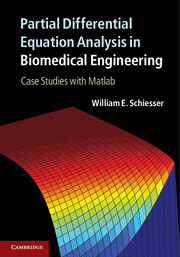Book contents
- Frontmatter
- Contents
- Preface
- 1 Introduction to partial differential equation integration in space and time
- 2 Antibody binding kinetics
- 3 Acid-mediated tumor growth
- 4 Retinal O2 transport
- 5 Hemodialyzer dynamics
- 6 Epidermal wound healing
- 7 Drug distribution from a polymer matrix
- Appendix 1 Origin of convection-diffusion-reaction PDEs
- Appendix 2 Stiffness and eigenvalue analysis of ODE systems
- Index
- References
4 - Retinal O2 transport
Published online by Cambridge University Press: 05 December 2012
- Frontmatter
- Contents
- Preface
- 1 Introduction to partial differential equation integration in space and time
- 2 Antibody binding kinetics
- 3 Acid-mediated tumor growth
- 4 Retinal O2 transport
- 5 Hemodialyzer dynamics
- 6 Epidermal wound healing
- 7 Drug distribution from a polymer matrix
- Appendix 1 Origin of convection-diffusion-reaction PDEs
- Appendix 2 Stiffness and eigenvalue analysis of ODE systems
- Index
- References
Summary
The continuous transport of O2 in the retina is essential for the functioning of the photoreceptor cells (rods and cones) that provide vision. The O2 originates in the blood supply to the retina and is transported by diffusion through several layers of cells to the photoreceptors. In the model discussed next, the O2 transport is considered through four layers with metabolism in each layer that consumes O2. The model can be used to study how much O2 arrives for use by the photoreceptors under varying conditions.
Four-section PDE model
The retinal O2 transport model is explained in Fig. 4.1 primarily with words. We can note the following details about the model represented in Fig. 4.1:
The model has four sections, as discussed in [1, 2]:
– Inner retina (IR),
– Outer retina (OR),
– Fluid layer (FL),
– Choriocapillaris (CC).
• At the left boundary, z = zL (see Fig. 4.1), the O2 pressure is specified. Since the dependent variable, O2 pressure, PIR(z = zL, t) = PIR-S, is specified, this is a Dirichlet BC as discussed in Section 1.3.1.
• At the right boundary, z = zCC, the O2 pressure is specified, typically normal breathing pressure. Since the dependent variable, O2 pressure, PCC(z = zCC, t) = PCC-S, is specified, this is a Dirichlet BC as discussed in Section 1.3.1.
[…]
Information
- Type
- Chapter
- Information
- Partial Differential Equation Analysis in Biomedical EngineeringCase Studies with Matlab, pp. 221 - 283Publisher: Cambridge University PressPrint publication year: 2012
